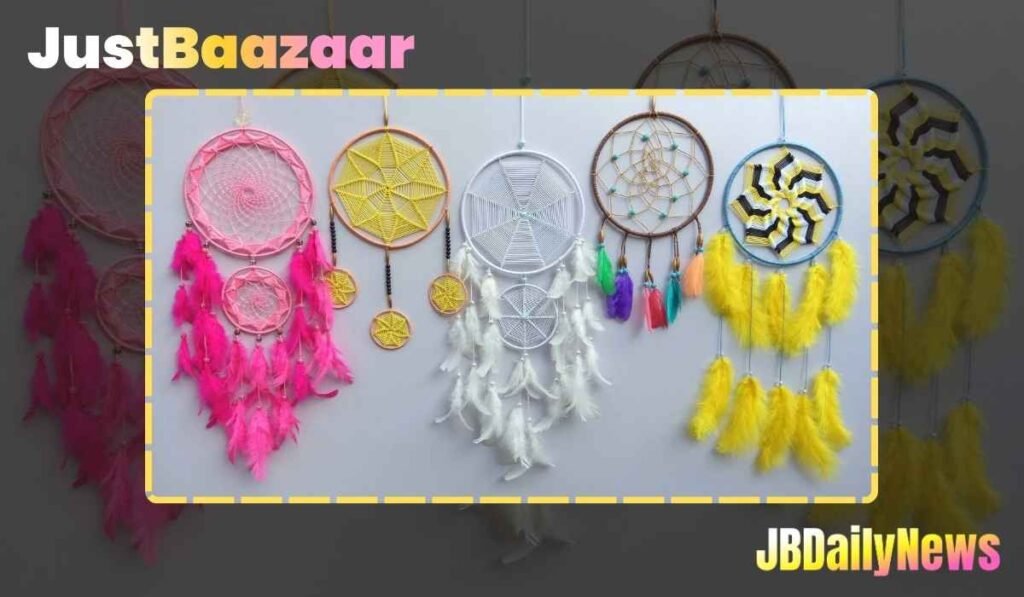Dream catchers are more than just beautiful decorative pieces; they are symbols with deep cultural significance and are believed to have powerful effects on the quality of sleep. These enchanting objects have become quite popular worldwide, often found hanging above beds, windows, or in sacred spaces. In this detailed guide, we will explore the history, significance, and how to make your own dream catcher at home.

What is a Dream Catcher?
A dream catcher is a symbolic object that originates from Native American culture, particularly the Ojibwa (Chippewa) tribe, though its usage has spread widely across different Indigenous cultures in North America. The object itself is composed of a circular frame, often made from natural materials like willow branches or metal, with a woven web or net at its center. Traditionally, the dream catcher was hung over a sleeping person’s bed to offer protection from bad dreams, evil spirits, and negative energies.
The design of the dream catcher holds deep spiritual meaning. The circle symbolizes the never-ending cycle of life, representing wholeness and unity, while the web or net in the center is meant to trap bad dreams. The hole in the middle of the web is said to let only the good dreams or positive energy pass through, gently descending on the sleeper. The feathers hanging from the bottom of the dream catcher symbolize the breath or the air, and they are said to represent the passage of good dreams, guiding them toward the sleeper.
Over time, dream catchers have gained global popularity, evolving from a spiritual tool into a universal symbol of protection, positivity, and beauty. Today, they are not only used in Native American traditions but are also cherished by people of many different cultures around the world.
How to Make a Dream Catcher
Making a dream catcher at home is a wonderful craft project that allows for creativity and personalization. The process connects you to the ancient tradition of crafting a protective and meaningful object, while also providing a sense of accomplishment. Here’s an in-depth explanation of the steps involved in making your own dream catcher:
Materials Needed:
- A Hoop: This can be a metal ring, embroidery hoop, or a natural vine ring. The hoop forms the structure of the dream catcher.
- String or Yarn: You will use this to create the web. Choose thread or yarn in colors that resonate with you or that you associate with specific emotions or intentions.
- Feathers: These are traditionally added to the bottom of the dream catcher, often in varying lengths. Different feathers carry different symbolic meanings.
- Beads: Optional, but beads can be threaded onto the yarn while you’re creating the web, adding decoration as well as symbolism.
- Glue Gun or Needle and Thread: For securing beads, feathers, or other decorative elements to your dream catcher.
- Scissors: To trim excess string or fabric.
- Craft Wire or Hanging Thread: This is used to hang your dream catcher once it’s completed.
Steps to Make a Dream Catcher:
- Wrap the Hoop: Begin by wrapping your hoop with yarn, fabric, or leather to give it a finished look. This is a great opportunity to use materials that are meaningful to you, like a piece of leather or a specific color of thread.
- Create the Web: Once the hoop is wrapped, tie a knot at one end of your string and attach it to the hoop. Begin weaving the string around the hoop in a spiral, moving outward toward the edge of the hoop. As you create the web, you can make loops or knots to secure the string in place. Remember to leave a small hole in the center, which is where good dreams will pass through.
- Incorporate Beads: Beads can be threaded onto the yarn as you weave. Traditionally, beads are placed on the web to represent good dreams or positive thoughts. You can also place beads at the center of the web or at intervals along the threads for added beauty.
- Attach Feathers: Once the web is complete, tie feathers to the bottom of the hoop. The feathers represent breath or air, essential for life. You can use several feathers to symbolize various energies, such as one for each element, or simply choose the ones that speak to you.
- Add a Hanging String: Tie a small piece of string at the top of the hoop to create a loop for hanging your dream catcher. This loop will allow you to hang it in your chosen spot.
By following these steps, you can create a dream catcher that is uniquely yours, imbued with your personal energy and intentions.
Where to Hang a Dream Catcher?
The location of your dream catcher is just as important as its creation. Traditionally, dream catchers were placed in strategic spots where their protective properties could be most effective. Here’s an elaboration on the best places to hang a dream catcher:
- Above the Bed: The most common and traditional location for a dream catcher is above the bed, specifically over the sleeping area. This placement is said to protect the sleeper from nightmares or negative dreams, filtering out bad energy and ensuring peaceful sleep. Many people hang dream catchers over their bed’s headrest to create a shield against nightmares.
- Near Windows: Placing a dream catcher near a window can help filter out negative energy entering the room from the outside. Some believe that the window serves as a passage for both good and bad energy, and the dream catcher serves as a filter to block unwanted influences.
- In Sacred Spaces: Dream catchers can also be hung in spaces meant for relaxation, reflection, or meditation, like altars or meditation rooms. The dream catcher’s symbolism of protection and spiritual connection is particularly powerful in such environments. Hanging a dream catcher in a meditation room is thought to help maintain a serene, peaceful atmosphere conducive to mindfulness.
- In Baby’s Room: Another popular location for a dream catcher is in the nursery. Many parents hang a dream catcher above their baby’s crib to protect the child from bad dreams and to promote peaceful, restful sleep.
- In Cars and Offices: Some individuals choose to hang dream catchers in their vehicles or offices as a source of calm and protection throughout their day. In cars, dream catchers are thought to bring peace to the driver, ensuring a smooth journey free of negativity. In workspaces, they are believed to help reduce stress and encourage positive energy.
How to Make a Dream Catcher at Home?
Creating a dream catcher at home can be a deeply personal and therapeutic process. Here’s a more detailed explanation of how to make a dream catcher at home, including ideas for customization:
Choose Materials with Personal Meaning:
Select materials that hold significance to you. For instance, if you want your dream catcher to attract love and peace, choose pink or lavender yarn, and add rose quartz beads or crystals. The choice of beads, feathers, or even the type of fabric you use can reflect your personality or spiritual beliefs.
Experiment with Different Shapes:
While traditional dream catchers are round, you can experiment with different shapes such as stars, hearts, or even a crescent moon. The shape of your dream catcher can symbolize different things, such as love (heart) or transformation (crescent).
Add Unique Symbols:
Incorporating symbols that have personal meaning—like charms, specific gemstones, or feathers from birds you connect with—can make your dream catcher even more unique. For example, a turquoise bead might represent healing, while an owl feather could symbolize wisdom.
Create a Symbolic Web:
Instead of the traditional spiral web, try creating a specific pattern with your string or yarn. For example, you can weave a web with a specific number of knots or layers to signify important milestones or intentions in your life.
What is the Use of a Dream Catcher?
While the primary function of a dream catcher is to filter bad dreams and allow good dreams to pass through, it holds multiple meanings and uses depending on one’s cultural background, beliefs, and personal intentions. Below, we delve deeper into the various uses and benefits of dream catchers:
Protection from Nightmares:
The traditional and most well-known use of a dream catcher is to protect the sleeper from bad dreams, evil spirits, and negative energies. The web in the center of the dream catcher is said to trap bad dreams, which are destroyed by the sunlight in the morning, while the good dreams pass through the hole in the center.
Attracting Positive Energy:
Many people believe that dream catchers can attract and filter positive energy, allowing only good vibes and dreams to pass through. The gentle energy from a dream catcher is said to promote peace, comfort, and tranquility in a space, enhancing one’s environment.
Spiritual and Cultural Significance:
For many, dream catchers hold deep spiritual meaning, symbolizing connection to ancestors, the divine, or the spirit world. Native American cultures view them as protective charms, a way to invoke blessings and guidance from higher realms. They can serve as reminders of personal spirituality or growth.
Aesthetic and Emotional Benefits:
Aside from their spiritual and symbolic meanings, dream catchers are often used for their aesthetic appeal. The intricate designs, soothing colors, and natural elements used in their construction make them beautiful and calming decor pieces for any home or space.
what does dream catcher do
A dream catcher is believed to serve as a protective charm that filters and protects individuals during sleep. Traditionally, it is hung above the bed, where it is thought to trap bad dreams in the web while allowing good dreams to pass through the center. The bad dreams are said to get caught in the web and are destroyed by the light of the morning sun, while the good dreams flow down the feathers to the sleeper.
In addition to its role in protecting against nightmares, a dream catcher is also considered a symbol of positivity, peace, and spiritual connection, often used to promote good energy in a room or space. It’s thought to bring harmony, balance, and positive vibes to its surroundings.
Conclusion
Dream catchers are not only a fascinating cultural symbol but also powerful objects for personal and spiritual protection. Whether you choose to make your own or buy one, these captivating creations offer more than just a pretty piece of art; they serve as reminders of the importance of positive energy, good dreams, and spiritual harmony in our lives. By crafting your own dream catcher and hanging it in the right place, you can invite peace, protection, and positive energies into your environment.















